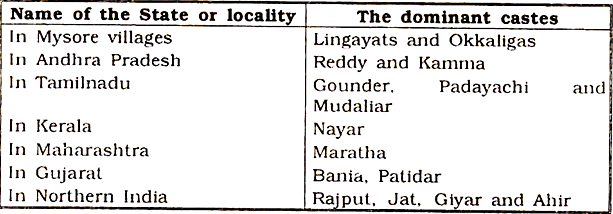Dominant Caste | Anthropology Optional for UPSC PDF Download
Meaning
- The concept of dominant caste has been used for the first time in sociological literature by an eminent sociologist.
- Prof. M.N. Srinivas in his essay “The Social System of a Mysore Village”, which was written after his study of village Rampura.
- Rampura village is a little away from Mysore city of Karnataka.
- While constructing the concept, Srinivas was unconsciously influenced by African studies on the dominant clan and dominant lineage.
- Dumont and Pocock believed that Srinivas has adopted the term from the study of African society where the concepts of dominant clan and dominant lineage were used. The term dominant caste is used to refer to a caste which yields economic or political power and occupies a fairly high position in the hierarchy.
- Srinivas says that the existence of dominant caste is not particular to Rampura village only. It is also found in other villages of the country.
Here is a list of dominant castes
Definition of Dominant Caste
- “A caste may be said to be dominant when it preponderates numerically over other castes and when it also wields preponderant economic and political power. A large and powerful caste group can be more easily dominant if its position in the local caste hierarchy is not too low.” —M.N. Srinivas
- McKim Marriott viewed that the concept of dominant caste in various studies of anthropological research lies on the political power which traditionally called as juridical power in village community and at times yields religious and quasi-divine power and the power to employ physical force.
- “A caste to be dominant, it should own a sizable amount of the arable land locally available, have strength of numbers and occupy a high place in the local hierarchy. When a caste has all the attributes of dominance, it may be said to enjoy a decisive dominance.” —M.N. Srinivas
Dimension of Functions of Dominant Caste
- The dominant caste often acts as a reference model to the lower caste group. The lower caste people imitate their behaviour, ritual pattern, customs etc. In this way, they help in cultural transmission.
- The dominant castes of a particular locality act as watch dogs of pluralistic culture and system. They set norms and regulations for social life. Anyone who violates the norms Is severely punished. Anil Bhatt has pointed out that the leaders of the locally dominant caste may arbitrate in village disputes. They decide the mode of rewards and punishment. They may determine civic and economic privileges.
- Dominant castes are the main power holders. They establish contacts with the outside government officials, elected representatives and political leaders. They influence the political process.
- Dominant castes because of their dominant position exploit all the developmental sources in their favour. They act as agents of rehabilitation programmes. They accelerate the process of socio-economic developments.
- The Dominant castes set values and norms for the community. Traditionally, its primary functions were Judicial, executive and legitimacy. They form the vital link between the villages and the other world. They also help in the socialisation process.
- Due to dominant position in rural society, they control the rural economy in various ways and means.
- Dominant castes play a greater role in the process of modernisation.
Criticisms
- Adrian C. Mayer (1958) has questioned the stress on numerical dominance. He has also pointed out to the failure of the concept to deal with the fact that power and prestige are often in the hands of few individuals. He has also pointed out to the need to recognise that dominance is not simply an one way affair since dominance is an object of emulation for the caste beneath it in the hierarchy.
- Louis Dumont has claimed that dominance should be considered as a purely secular phenomenon distinct from hierarchy which is purely ritual.
- Gardener reviewed that “dominance” should not be conceptualized in the form of caste only.
As there are four basic levels of dominant castes- The ruler
- The regionally dominant caste
- The locally dominant caste
- The village level landed pattern of dominant caste.
- David Pocock observes that Sanskritizatlon is outside the pale of pan-Indian culture and it is a manifestation of highly localised process of cultural change. At the micro-structural level of villages and other territorial groups there were functional equivalents of the kingly role represented by what Srinivas called “dominant-castes”.
- With the land reforms, big landowning class has ceased to be an important element of dominance. Andre Beteille observes that in place of big landowning class, the strength of numerical support has become a decisive factor in the formation of a dominant caste.
- Dominant caste is not always numerically a preponderant caste. D.N. Majumdar observes that the scheduled castes preponderate in many villages. But the people belonging to the upper caste exercise power and authority in such villages.
Conclusion
The concept of dominant caste, introduced by Prof. M.N. Srinivas, is a significant aspect of rural sociology in India. Dominant castes are those that hold substantial economic, political, and social power within a village or region, often influencing local norms, values, and development. Although the concept has been criticized for its focus on numerical dominance and its limitations in addressing power dynamics at various levels, it remains a useful framework for understanding the complex relationships between different caste groups in rural India. As land reforms and other socio-economic changes continue to reshape rural society, the concept of dominant caste may evolve to incorporate new factors and dimensions of power, further enriching our understanding of caste dynamics in India.
|
108 videos|243 docs
|


















